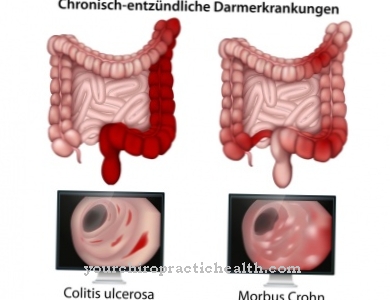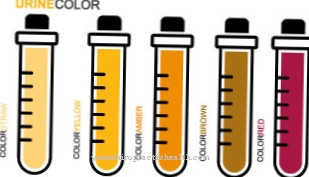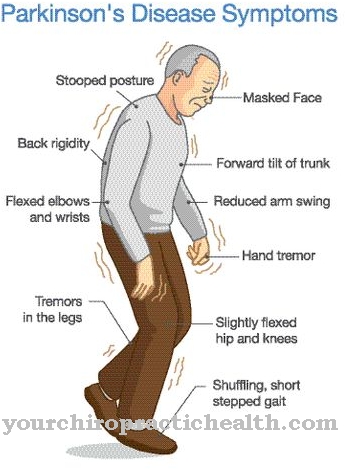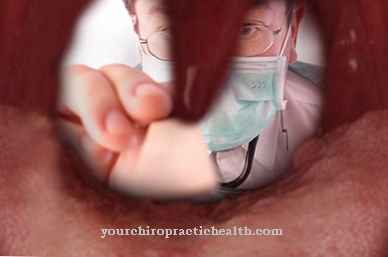A Pericardial effusion is an excessive accumulation of fluid in the pericardial cavity. There are very good treatment methods and chances of recovery; only in very few cases is surgical intervention necessary.
What is a pericardial effusion?

© SciePro - stock.adobe.com
At a Pericardial effusion, also Pericardium effusion called, there is an excessive build-up of fluid between the pericardium and the skin of the heart.
The gap between the pericardium and the skin of the heart, the pericardial cavity, is filled with a little fluid, even in the physiological state, in order to reduce the frictional resistance with each heartbeat. However, if more fluid is formed than it is taken up again, fluid collects in the pericardial cavity and pericardial effusion occurs. If the amount of fluid in the pericardial cavity increases sharply, the heart muscle is constricted and the heart chambers can no longer fill up with enough blood.
With small or chronic pericardial effusions, symptoms rarely occur because the amount of pericardial fluid is only slightly increased. With more severe pericardial effusions, a variety of complaints can occur. A decrease in the heart's pumping capacity is particularly typical. If the effusion is severe, symptoms of heart failure, such as blue lips or congestion of the blood in the neck veins, occur.
causes
There are many causes for one Pericardial effusion. These include a ventricular rupture, i.e. a tear in the heart chamber or an aortic dissection, a rupture of the main artery.
Various infectious diseases can lead to the clinical picture of pericardial effusion, including HIV, herpes and tuberculosis, among others. Due to the inadequate pumping capacity of the heart in the case of heart failure, pathological fluid accumulation in the pericardial cavity can also occur here. Postcardiotomy syndrome, an inflammation of the pericardium that can lead to pericardial effusion, can occur as a result of an operation on the heart.
Pericardial effusion is a possible symptom of some cancers, including breast cancer, leukemia, and lung cancer. Some immunological diseases such as rheumatism, Crohn's disease or ulcerative colitis can also lead to pericardial effusion.
Symptoms, ailments & signs
A small pericardial effusion doesn't necessarily cause symptoms. Larger hematomas lead to poor circulation and chest pain. An acute drop in blood pressure can also occur. Those affected usually feel an inner restlessness, which increases in intensity as the disease progresses. As a result of the reduced pumping capacity and the accumulation of influence, accompanying symptoms such as fatigue, breathing difficulties and cardiac arrhythmias also occur.
Those affected are generally less resilient and more quickly exhausted with physical activity. The lack of oxygen supply can also cause abnormal breathing noises. This is accompanied by external symptoms such as blue lips and cold or numb fingers. As a result of the malaise, an increasing loss of appetite is also noticeable.
As a result, the sick lose body weight and often suffer from deficiency symptoms, which intensify the original symptoms. If a pericardial effusion is detected early, there are usually no further complications. The symptoms subside as soon as the hematoma has subsided.
Usually the patient is completely symptom-free again after one to two weeks. However, if the hematoma is treated too late or inadequately, serious secondary symptoms such as tachycardia or pauses in breathing can set in. In severe cases, pericardial effusion can lead to death.
Diagnosis & course
The first diagnostic measure is when one is suspected Pericardial effusion taken is an ultrasound scan. In some cases, computed tomography is also ordered. Then fluid is taken from the pericardial cavity and examined in the laboratory for pathogens or cancer cells.
The attending physician identifies existing illnesses as part of an anamnesis; this is particularly important in order to be able to narrow down the possible causes. The history of a pericardial effusion is usually unspecific. Patients usually report shortness of breath, exhaustion or coughing. The increased pericardial fluid that surrounds the heart is visible in the EKG. In most cases this is sufficient to establish a diagnosis.
The further course of a pericardial effusion depends on the severity of the effusion, the underlying disease, and the treatment. Chronic pericardial effusions are usually not a big problem and may not need treatment. Acute pericardial effusions can usually be treated well, so that patients rarely have to reckon with consequential damage.
Complications
As a rule, there are no particular complications or other serious complaints with pericardial effusion. Surgical intervention is also only seldom necessary, especially in serious cases. In most cases, patients also have heart problems due to the pericardial effusion. This leads to shortness of breath and a significantly reduced resilience of the patient.
This also leads to permanent exhaustion and tiredness and has a very negative effect on the quality of life of the person concerned. There is also a cough and hyperventilation. The patients themselves complain of anxiety and, in some cases, feelings of confusion and fear. Loss of appetite also occurs.
Due to the lack of oxygen in the body, it is not uncommon for pericardial effusion to turn the skin blue. The internal organs can also be irreversibly damaged in the long term. Treatment of pericardial effusion is usually done with the help of antibiotics or pain relievers. There are no complications, the course of the disease is generally positive.
When should you go to the doctor?
A slight pericardial effusion can be symptomatic. A medical evaluation is necessary in the event of noticeable symptoms such as a palpable heart attack or an increased pulse. A major pericardial effusion is a medical emergency. If breathing and circulatory problems such as shortness of breath or a rapid pulse occur, the emergency services must be called immediately. If the victim loses consciousness, first aid should be given.
After the first aid, the sick person must be treated as an inpatient in the hospital. Regular follow-up examinations are necessary after discharge from the clinic. It is also important to determine the cause of the pericadial effusion, which may require lengthy examinations by various specialists.
Pericardial effusion is treated by a cardiologist. Depending on the symptoms, internists and the family doctor can be involved in the therapy. People who have pericarditis suffer particularly often from pericardial effusion. Patients with other heart diseases also belong to the risk groups and should have the described symptoms cleared up quickly by a doctor. Children, the elderly, pregnant women and physically ailing people should have any unusual symptoms in the heart area examined quickly, especially if they get worse and do not go away on their own.
Treatment & Therapy
Treating a Pericardial effusion depends on the underlying condition. In the case of a slight pericardial effusion, for example in the context of infections, it is often sufficient to keep bed rest and to take it easy for a while. Nevertheless, going to the doctor is essential.
In many cases, drug therapy is useful to relieve pain and reduce inflammation. Usually, mild pain relievers such as ibuprofen are used here. Depending on the underlying disease, specific therapy must also be initiated, such as the administration of antibiotics for infections.
If the pericardial effusion is severe or if drug therapy does not work, a pericardial puncture is usually performed. The attending physician penetrates the pericardium with a needle and removes fluid with a cannula. During the pericardial puncture, the doctor checks the procedure using an echocardiography device. A puncture is usually used to procure material for further examination in the laboratory, but a certain amount of fluid can also be removed.
If there is a large amount of fluid in the pericardial cavity, a pericardial drainage must be performed. The effusion is drained through a catheter. Surgical intervention is necessary in particularly severe, treatment-resistant cases. A small window is cut in the pericardium so that the fluid can run out; this procedure is called pericardial fenestration. A pericardectomy, i.e. a complete removal of the pericardium, is only necessary in exceptional cases.
Outlook & forecast
The outlook for patients with pericardial effusion is difficult to assess. A pericardial effusion is only spoken of when the normal amount of tissue fluid in the pericardium is exceeded. The pericardium may have to be punctured for larger amounts of fluid. The prognosis depends, among other things, on whether it is an acute or a chronic pericardial effusion. Acute pericardial effusion can occur as a result of a heart attack, a transplant, an accident or a similarly serious incident, including cancer. The pericardial effusion caused by tuberculosis, however, is rarely found.
The prognosis for pericardial effusion deteriorates significantly if a cardiac tamponade occurs due to larger fluid accumulations. The heart can no longer perform its normal work. A puncture can save lives. It improves the prognosis. The only question is how long-term.
If the pericardial effusion is chronic, the pericardium is repeatedly loaded with large amounts of fluid. Therefore, in addition to the technically demanding puncture, chronic pericardial effusion requires accompanying drug treatment. There is also the possibility of improving the prognosis with a transcutaneous pericardiotomy. Instead of a puncture, a drain is placed. This remains on site for several days.
The prognosis is rarely improved by using a catheter and a compressed air balloon. This allows the pericardial effusion to run independently over a longer period of time.
prevention
Targeted measures around one Pericardial effusion So far there is nothing to prevent it. Of course, as with almost every disease of the heart, a healthy lifestyle, abstaining from alcohol and smoking, as well as a healthy amount of sport and exercise can also contribute to the prophylaxis against pericardial effusion.
Aftercare
After the treatment of a pericardial effusion, at least one check-up by the responsible family doctor or cardiologist is necessary. The doctor first asks about the typical symptoms that can occur in connection with an effusion and clarifies open questions from the patient. As part of the anamnesis, the dose of the prescribed medication is also checked and adjusted if necessary.
If side effects or interactions occur, the doctor must be informed about them as part of the follow-up care. The physical examination focuses on scanning the heart, listening to it and, if necessary, taking an ultrasound image. With the help of the imaging data, the doctor can determine relatively quickly whether the effusion has subsided. Depending on how the follow-up examination turns out, further measures can be taken.
If no abnormalities were found, no further follow-up appointments are usually necessary. However, the patient should have a cardiac examination at least once a year. In the case of a difficult course with recurring effusions, regular check-ups are necessary. Small effusions must be observed so that an operation can be initiated quickly if necessary. Close consultation with the doctor is necessary, especially in the case of recurrent pericardial effusions.
You can do that yourself
Pericardial effusion sufferers are well advised to keep calm. In many cases, just taking it easy and getting enough sleep will alleviate the symptoms. Relaxation procedures, which the person concerned can carry out independently at any time, help to reduce stress and hectic rush. Through techniques of yoga, meditation or autogenic training, inner tension can be released and new strength can be built up.
Avoid being overweight or gaining weight. This puts additional strain on the heart and can no longer meet the requirements of the organism in the further course. Your own body weight should ideally be within the limits of the BMI. A healthy and balanced diet is important for maintaining health and strengthening the body's defenses. The consumption of harmful substances such as alcohol or nicotine should be avoided.
The patient helps himself if he takes in sufficient fluids and spends time in the fresh air every day. Your own rooms should be ventilated regularly and filled with new oxygen. In addition, the sleeping conditions should be optimized so that the body can recover sufficiently during the rest phases. Compliance with a bed rest is necessary. Sports activities or everyday obligations are to be avoided and should be taken over by relatives or friends.


.jpg)

.jpg)






















